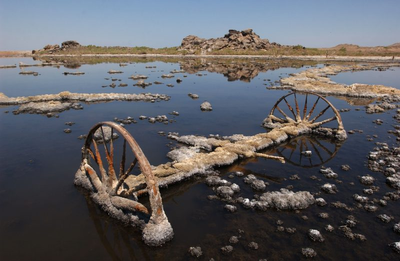
(KTLA) -- The Salton Sea, once a resort destination and now largely overlooked, could be the site of California's next gold rush – this time involving lithium.
A new study from the U.S. Department of Energy shows the dying lake, which sits between the Coachella and Imperial valleys in California's southern desert, is brimming with so-called “white gold”: enough to build batteries for 375 million electric vehicles.
This makes it one of the largest lithium brine deposits in the world.
Analysts from the University of California, Berkeley measured lithium concentrations in the Salton Sea’s rocks and created computer models to estimate its potential production over the next 30 years. They also looked at scenarios for recovering the metal, which powers everything from EVs to cellphones and tablets, laptops, tools and vaping devices.
Their analysis found that, with technological advances, the region could produce more than 3,400 kilotons of lithium and create an economic boom for the region where, according to the U.S. Census Bureau, 21% of the population lives in poverty.
For years, experts have known the sea contains lithium but not until now had the government estimated how much.
“This report confirms the once-in-a-generation opportunity to build a domestic lithium industry at home while also expanding clean, flexible electricity generation,” said Jeff Marootian, principal deputy assistant secretary for Energy Efficiency and Renewable Energy. “Using American innovation, we can lead the clean energy future, create jobs and a strong domestic supply chain, and boost our national energy security.”
The Salton Sea is California’s largest lake and was formed when diverted Colorado River floodwaters breached an irrigation canal in 1905. Over the years, its water has been maintained by irrigation runoff and has become increasingly salty, impacting fish and wildlife.
It is also dying and heavily polluted.
Researchers from UC Riverside found the lake has lost roughly a third of its water over the past 25 years and the dry lakebed is "coated in the salty, toxic water, becomes dust that causes respiratory problems for nearby residents."